Men's magazines: an A to Z
Men's magazines, lad's magazines, glamour magazines, pin-up magazines and top-shelf magazines covered alphabetically. This page addresses Deluxe via Escort to Esquire. On other pages:Introduction
- 3D titles to Boys Toys
- Carnival to Cut
- Deluxe to Esquire (this page)
- Fable to Front
- The Gentleman's Magazine to The Humorist
- Ice to London Opinion
- Man to Maxim
- Mayfair to Monkey
- Nine to Playboy
- Razzle to Stuff
- T3 to Zoo Weekly
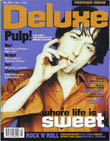 Deluxe launch issue from Face publisher Wagadon. Pulp's Jarvis Cocker is on the cover |
Deluxe [closed]Wagadon, May 1998-Jan/Feb 1999Launched as a reaction to the flesh-driven strategies of lads' magazines FHM and Loaded. Editor Andrew Harrison introduced the concept: 'Deluxe is here because a group of people got tired of being told that the same clapped-out subjects were the be-all and end-all of men's interests. They got bored of pro-celebrity shark-fishing and Z-list actresses in their knickers. The world is more interesting, and more complicated, than all that...'Music was a mainstay of the title and Pulp's Jarvis Cocker was on the first cover. Unfortunately, the new mix did not work. Despite a redesign (including a move from stapled to a more upmarket perfect-bound cover) and a bigger 'babe factor', the magazine failed to work up towards a 150,000 sales target. It closed at issue 8 with sales of fewer than 80,000. The main cover lines were: 'She wants your sex: your girlfriend's filthy fantasies' and 'Mine's a vodka and Red Bull. Davina Murphy will see you now...' with the semi-clad Hollyoaks actress on the cover. Even worse, the failure of this and its women's magazine Frank was to drain Face and Arena publisher Wagadon, which sold out to Emap six months later. Wagadon profile |
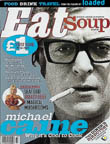 Eat Soup, a Loaded spin-off |
Eat Soup [closed]IPC, October 1996Short-lived food title as a spin-off from lads' magazine Loaded. IPC profile |
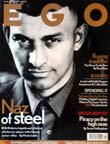 Ego put boxer Prince Naseem on its first cover in 1999 |
Ego [closed]Portfolio, March 1999-?Ego took up the challenge tro create a serious men's magazine in the midst of the lead's mag culture (with Marie Sim'one as editor). ‘Ego has landed at WHS,’ read its advertising campaign; unfortunately, it wasn't able to stay long. |
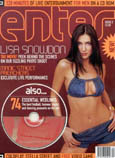 Enter, a digital men's magazine on CD-Rom
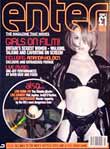 |
Enter (CD-Rom) [closed]Pure Communications, March 2001 (on sale: no cover date)-?A monthly CD-Rom for PC and Mac run by editor Sam Delaney (ex-Later). 'The magazine that moves' was an interactive CD-Rom (IPC's Unzip, Dennis's Blender and a children's title Fun Online from Egmont all tried CD-Rom magazines in the early 1990s). Men's lifestyle, age 18-35. Lead feature: 'Girls on film: Britain's sexiest women – walking, talking and cavorting.' First launched in Ireland in 2000. Target sales were 150,000. |
Escape [closed]Dennis, 1996-?Short-lived title from Maxim publisher Dennis aiming to explore the World-Wide Web. The first issue was withdrawn for legal reasons. Jennifer Aniston was on the cover. Dennis profile |
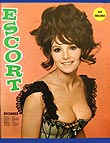 Escort in the 1960s |
Escort [closed]1958-1971Monthly pin-up magazine that closed in 1971, then re-emerged as a top-shelf magazine 10 years later published by Paul Raymond. |
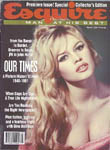 Esquire featured Brigitte Bardot on its first cover |
Esquire (UK)National Magazines, 1953-1959; March 1991-In 1953, Esquire tried to launch a British edition of this men's magazine, but this folded after six years. The title returned to the battle in March 1991 with Lee Eisenberg as editor-in-chief and Alex Finer as editor. Unusually, it had a woman on the cover – a late-1950s photograph of Brigitte Bardot. It established its position but at a low level of sales. National Magazines profile |
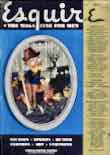 Esquire magazine cover from the US in 1935 |
Esquire (US)Hearst, 1933-In the US, Esquire was founded in 1933. Its origins dated back two years in Apparel Arts, a glossy quarterly for clothes wholesalers, which customers in shops started to take home. The editor was Arnold Gingrich, who worked on the title in various roles until his death in 1976. He set out his aims: Esquire aims to become the common denominator of masculine interests – to be all things to all men... It aims to be among other things, a fashion guide for men. But it never intends to become, by any possible stretch of the imagination, a primer for fops.Esquire established itself in the war years with its pin-up illustrations and calendars. The first fold-out pin-up appeared in October 1940 and the calendar by Peruvian-born Alberto Vargas that year sold 320,000 copies – by 1943 a million calendars had sold. (It was his work that inspired aircrews to paint women on the sides of their planes.) However, Vargas and the publisher fell out in 1946 and the magazine, which had persuaded him to sign his work as Varga, copyrighted that name to stop him using it. In 1957, Esquire spun off its Gentleman's Quarterly supplement, which was to end up in the hands of Condé Nast and overtake its parent in terms of sales. The magazine reduced its reliance on pin-ups in the late 1950s after the launch of Playboy. Esquire was bought by Hearst in 1986. |
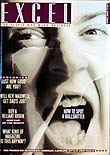 The coverline 'How to spot a bullshitter' led to advertising for Excel being banned |
Excel [closed]White Line Publishing, April 1988-?The first issue's main coverline 'How to spot a bullshitter' led to its advertising being banned on the London Tube and the editorial mix under Rod Fountain was seen as too yuppy and it soon folded (although the title would be used again more than once in the next decade). |
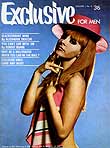 This 6th issue of Exclusive carried no advertising |
Exclusive [closed]Alex White & Co, Market Building, Guildford. Printed in Italy. Distributed by New English Library, Barnard’s Inn, Holborn. 3/6; 60pp. 1968-?There was no paid advertising in issue 6 shown here of this King-style men's monthly. The inside front and back covers were for the next issue and subscriptions; the back cover for distributor NEL. The editor and publisher was Alex White; the editorial director Victor Briggs; and art director Ken Freeman. It carrried a letter from a reader who complained about eight pages being blank in a previous issue! |
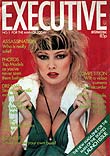 Janine Andrews on Executive's first issue |
Executive [closed]Fragilion, London. May 1982-?Brian Keogh was editor of this Playboy-style men's magazine 'For the man of today.' |


